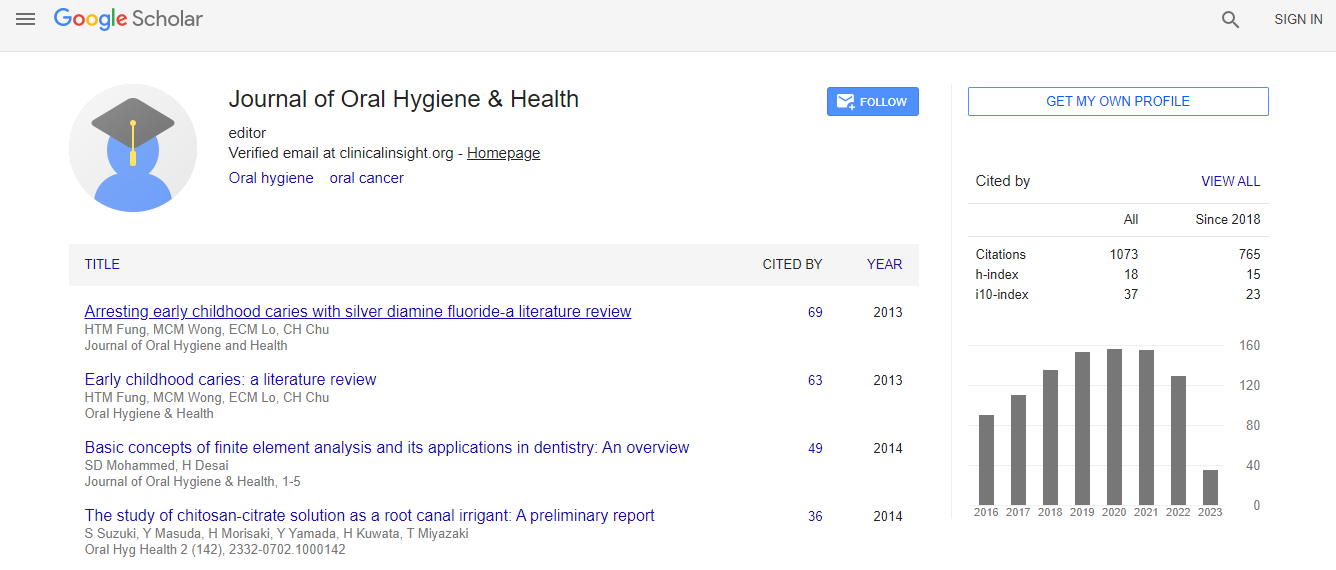Our Group organises 3000+ Global Conferenceseries Events every year across USA, Europe & Asia with support from 1000 more scientific Societies and Publishes 700+ Open Access Journals which contains over 50000 eminent personalities, reputed scientists as editorial board members.
Open Access Journals gaining more Readers and Citations
700 Journals and 15,000,000 Readers Each Journal is getting 25,000+ Readers
Google Scholar citation report
Citations : 1073
Journal of Oral Hygiene & Health received 1073 citations as per Google Scholar report
Journal of Oral Hygiene & Health peer review process verified at publons
Indexed In
- Index Copernicus
- Google Scholar
- Open J Gate
- JournalTOCs
- RefSeek
- Hamdard University
- EBSCO A-Z
- OCLC- WorldCat
- Publons
- Geneva Foundation for Medical Education and Research
- Euro Pub
- ICMJE
Useful Links
Recommended Journals
Related Subjects
Share This Page
Enhancing implant esthetics with multiple provisionalization
13th International Conference and Exhibition on Dental Medicine
Majid A Al-Harthi
Armed Forces Hospitals, KSA
Posters & Accepted Abstracts: J Oral Hyg Health
Abstract
Implant dentistry has come a long way since 1981 with great improvements made to achieve primary implant stability and improve bone-to-implant contact. The focus has since shifted toward creating an esthetic restoration that is indistinguishable from natural teeth and is stable over time. The success of a single tooth implant restoration in the esthetic zone depends not only on restored function but also on harmonious integration of the restoration into the patient's overall appearance, especially the peri-implant soft tissue. In spite of the available surgical techniques, Fu et al. 2011 proposed a guideline that demonstrates possible ways to increase the soft tissue thickness around implants, i.e. the �PDP management triad�: implant position (P), implant design (D) and prosthetic design (P). First, the implant position, and angulation are key determinants in ensuring that an implant supported restoration has functional and esthetic success through an ideal emergence profile. Second, implant diameter and platform design can help prevent crestal bone resorption, which is a great asset in preserving esthetics. Third, the prosthetic design can provide the additional space for soft tissue in growth to create a fuller soft tissue profile. To optimize esthetic treatment outcomes, the use of provisional restorations with adequate emergence profiles is recommended to guide and shape the peri-implant tissues prior to definitive restoration. It is preferable to place provisional restorations on the implant at the time the restorative procedure is started. This process will establish a natural and esthetic soft tissue form that will determine guidelines for laboratory fabrication of an anatomically appropriate soft tissue model. The case demonstrates the fabrication of a provisional temporary crown designed to optimize the development of ideal soft tissue form around implant in esthetic zone.Biography
Email: dr_maj@hotmail.com

 Spanish
Spanish  Chinese
Chinese  Russian
Russian  German
German  French
French  Japanese
Japanese  Portuguese
Portuguese  Hindi
Hindi 
